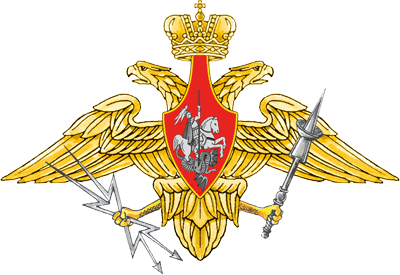|
|
|
|
Arkhangelsk, Russia ..
Russian Soyuz Launch of Glonass Satellite
From Plesetsk Cosmodrome 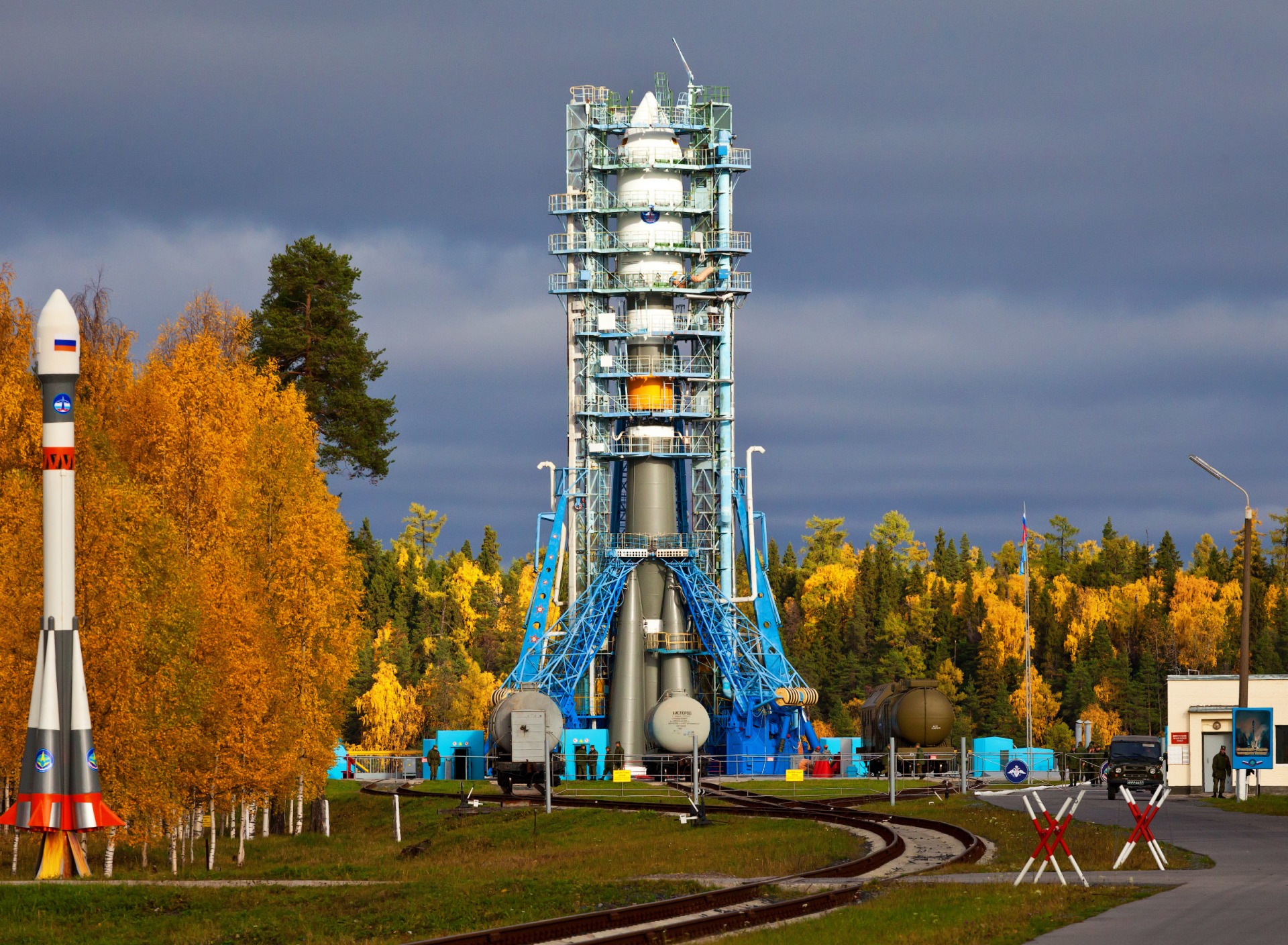 Russian Soyuz
Launch of Glonass Satellite From Plesetsk Cosmodrome. The third and
final launch of the week falls on Friday April 26 at 0523 UTC (0123 EDT)
this time from The Plesetsk Cosmodrome. Russia will be launching a
Soyuz 2-1B configuration Rocket with Fregat Upper Stage carrying the
Glosonass-M Navigation Satellite. - Photo By: Roscosmos
Plesetsk Cosmodrome (Russian: Космодром «Плесецк»), a Russian spaceport located in Mirny, Arkhangelsk Oblast, about 800 km north of Moscow and approximately 200 km south of Arkhangelsk, dates from 1957. Originally developed as an ICBM site for the R-7 missile, it also served for numerous satellite launches using the R-7 and other rockets. Its high latitude makes it useful only for certain types of launches, especially the Molniya orbits, so for much of the site's history it functioned as a secondary location, with most orbital launches taking place from Baikonur, in the Kazakh SSR. With the end of the Soviet Union, for Russia Baikonur became foreign territory which charged usage fees, so Plesetsk has seen considerably more activity since the 2000s. 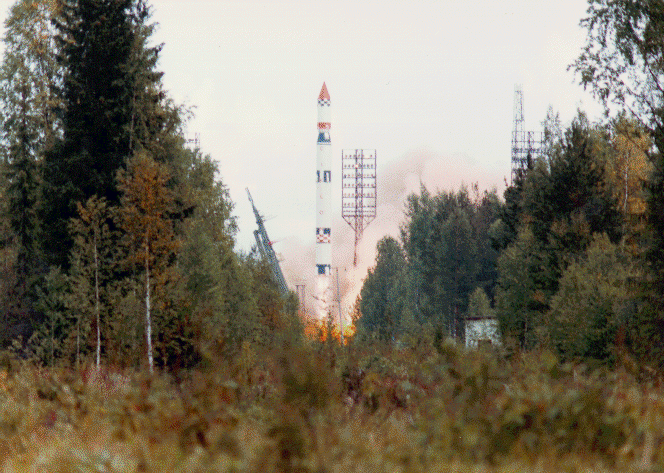 Cyclone-3 rocket launching Meteor-3 satellite (Plesetsk, 15 August 1991) Overview
Plesetsk (Lat: 62°55'32.32"N, Lon: 40°34'40.36"E) is used especially for military satellites placed into high inclination and polar orbits since the range for falling debris is clear to the north which is largely uninhabited Arctic and polar terrain. It is situated in a region of taiga, or flat terrain with boreal pine forests. The Soyuz rocket, Cosmos-3M, Rockot, Tsyklon, and Angara are launched from the Plesetsk Cosmodrome. The heavy Proton and Zenit rockets can only be land-launched from Baikonur (Zenit may also be launched at sea). History Plesetsk Cosmodrome was originally developed by the Soviet Union as a launch site for intercontinental ballistic missiles under the leadership and supervision of lieutenant general Galaktion Alpaidze. On 11 January 1957 the Soviet government passed the resolution about the foundation of special military object with secret name "Angara". This secret object had to be situated in Plesetsk District, Arhangelsk Oblast. It was named after the town of Plesetsk. The first Soviet Combat formation of intercontinental ballistic missiles R-7 of general designer Sergei Korolev had to be located in that place, in thick northern taiga to the south of Arkhangelsk. The official birthday of the proving ground was 15 July 1957. That day colonel Gregorjev assumed his post as the missile unit commander. By 15 July 1961, four missile complexes for ballistic missile R-7 were at combat status. In January 1963, a joint decision of the Central Committee of the CPSU and the USSR Council of Ministers created the "Research Proving Ground missile and space weapons USSR Ministry of Defense" near the Ilez railway station, Belsky District of Arkhangelsk Oblast. In the summer of 1963, the leadership of the state is decided on the use of launch facilities in Plesetsk for launching spacecraft. In September 1963 the Council of Ministers of the USSR 3rd ALM and NIIP converted to "53 minutes Research Proving Ground." Three test management, employees of combat duty, tests of rocket and space complexes, holding and processing of telemetry and trajectory measurements. And from 1964 on the basis of rocket connection started the establishment of research proving ground missiles and space weapons. Such conversion were the favorable geographical location and a significant number of systems already deployed by the end of 1964 were on duty, four launchers R-7A, seven PU P-16U and three PU R-9A. Since then, the landfill has developed in two directions: rocket and space. 17 March 1966 was the space birthday of Plesetsk. That day was the first missile launching of the rocket booster Vostok with space vehicle Cosmos 112. Since that time the rocket base Angara has become cosmodrome Plesetsk. Construction started in 1957 and it was declared operational for R-7 rockets in December 1959. The urban-type settlement of Plesetsk in Arkhangelsk Oblast had a railway station, essential for the transport of missile components. A new town for the support of the facility was named Mirny, Russian for "peaceful". By 1997, more than 1,500 launches to space had been made from the site, more than for any other launch facility, although the usage has declined significantly since the breakup of the Soviet Union. The existence of Plesetsk Cosmodrome was originally kept secret, but it was discovered by British physics teacher Geoffrey Perry and his students, who carefully analyzed the orbit of the Cosmos 112 satellite in 1966 and deduced it had not been launched from Baikonur Cosmodrome. Meteor 1-2 satellite launch from Plesetsk on 6 October 1969 was one of the earliest launches observed and photographed from Finland. After the end of the Cold War it was learned that the CIA had begun to suspect the existence of an ICBM launch site at Plesetsk in the late 1950s. The Soviet Union did not officially admit the existence of Plesetsk Cosmodrome until 1983. The use of the cosmodrome will likely increase in the future since there are concerns with security in operating the Baikonur Cosmodrome in now-independent Kazakhstan, which also demands rent for its continued use. Plesetsk is not ideally suited for low inclination or geostationary launches because of its high latitude of 62 degrees north (as compared to the Guiana Space Centre at 5° north or the Kennedy Space Center at 28° 31′ north). The new all-Russian Angara rocket was designed to be launched primarily from Plesetsk (and also eventually from the Vostochny Cosmodrome, which is still under construction as of mid-2014). The first test flight of the Angara took place successfully on 9 July 2014. In May 2007, a new ICBM, called the RS-24 has been tested and launched there, and is seen as eventually replacing the aging RS-18/UR-100Ns (SS-19 Stiletto) and RS-20/R-36Ms (SS-18 Satan) that are the backbone of Russia's missile forces. In September 2011 Space Forces spokesman Colonel Alexei Zolotukhin said Russia will spend over 5 billion rubles ($170m) on the development and expansion of the cosmodrome in 2011. This includes the reconstruction of a local motorway and modernizing the energy supply system. New facilities will be built, including a dormitory and hospital. List of launchpads
Accidents
SOURCE: Wikipedia 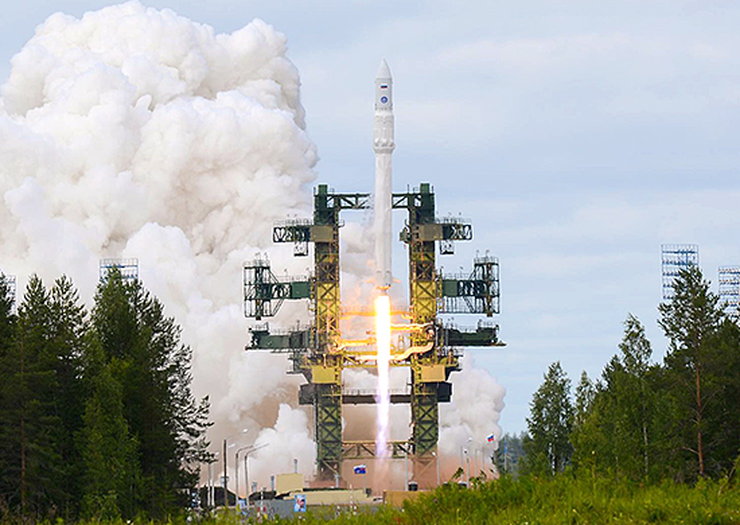 The Angara 1.2PP rocket lifts off from the Plesetsk Cosmodrome in Russia. Credit: Russian Ministry of Defense.
The 140-foot-tall Antara rocket launched from the Plesetsk Cosmodrome, a
military-run facility about 500 miles north of Moscow, at 1200 GMT (8
a.m. EDT), according to a statement from the Russian Ministry of
Defense. Launch occurred at 4 p.m. Moscow time.
Related Links:
|
|
 The "Semyorka" - the Rocket R7 by Sergei Korolyov in VDNH, Ostankino, Moscow. |
|
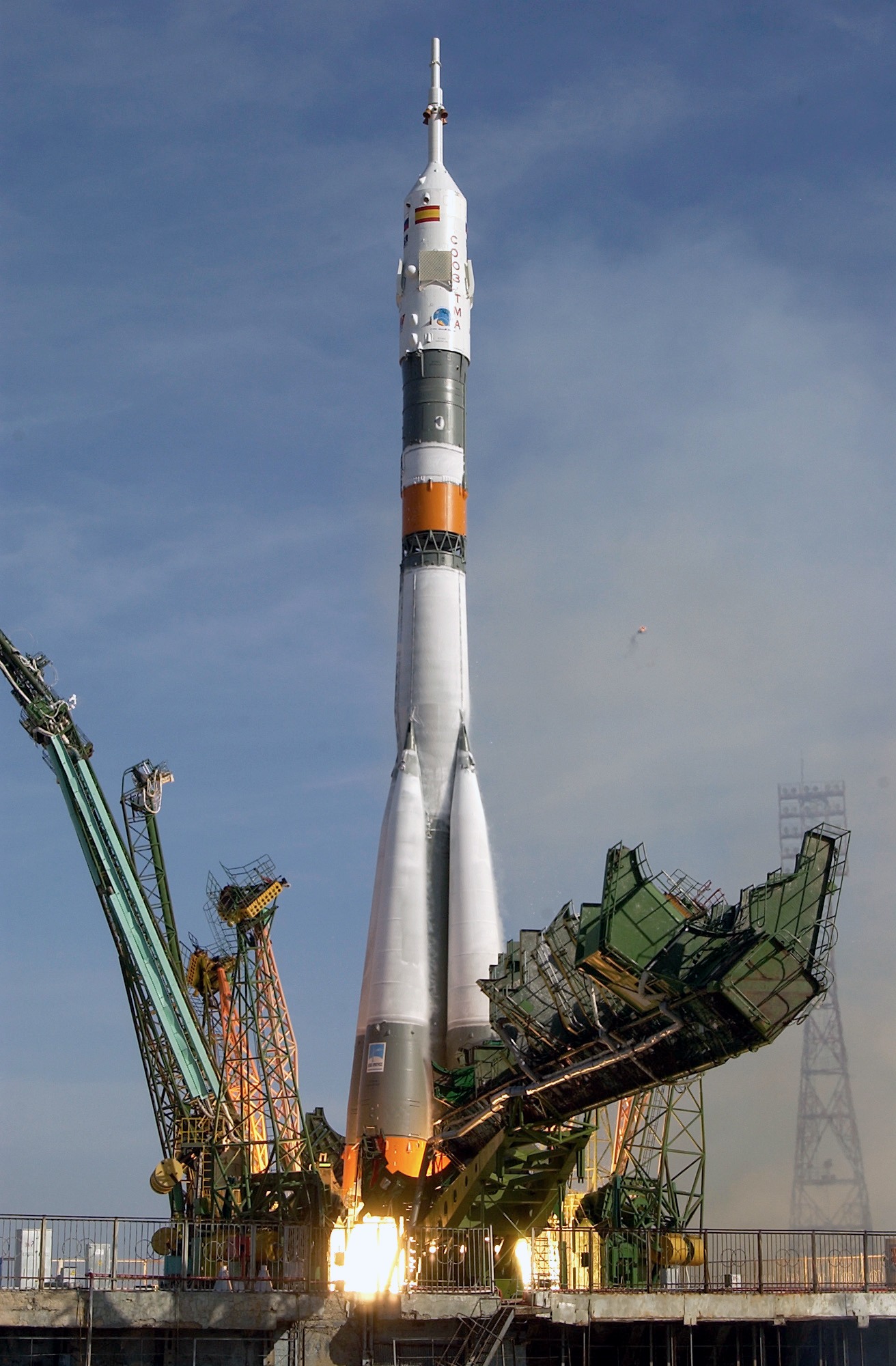 The Soyuz TMA-3
vehicle launches from the Baikonur Cosmodrome in Kazakhstan October 18,
2003, carrying astronaut C. Michael Foale, Expedition 8 mission
commander and NASA ISS science officer; cosmonaut Alexander Y. Kaleri,
Soyuz commander and flight engineer; and European Space Agency (ESA)
astronaut Pedro Duque of Spain to the International Space Station (ISS).
The trio will arrive at the ISS October 20, as Foale and Kaleri take
over command of Station operations for the next 6 1/2 months. Duque will
return to Earth October 28 with cosmonaut Yuri I. Malenchenko,
Expedition 7 mission commander, and astronaut Edward T. Lu, NASA ISS
science officer and flight engineer, in another Soyuz capsule already
docked to the ISS. Kaleri and Malenchenko represent Rosaviakosmos.
Credit: NASA/Bill Ingalls
|
|
| FAIR USE NOTICE: This page contains copyrighted material the use of which has not been specifically authorized by the copyright owner. Pegasus Research Consortium distributes this material without profit to those who have expressed a prior interest in receiving the included information for research and educational purposes. We believe this constitutes a fair use of any such copyrighted material as provided for in 17 U.S.C § 107. If you wish to use copyrighted material from this site for purposes of your own that go beyond fair use, you must obtain permission from the copyright owner. | |
|
|
